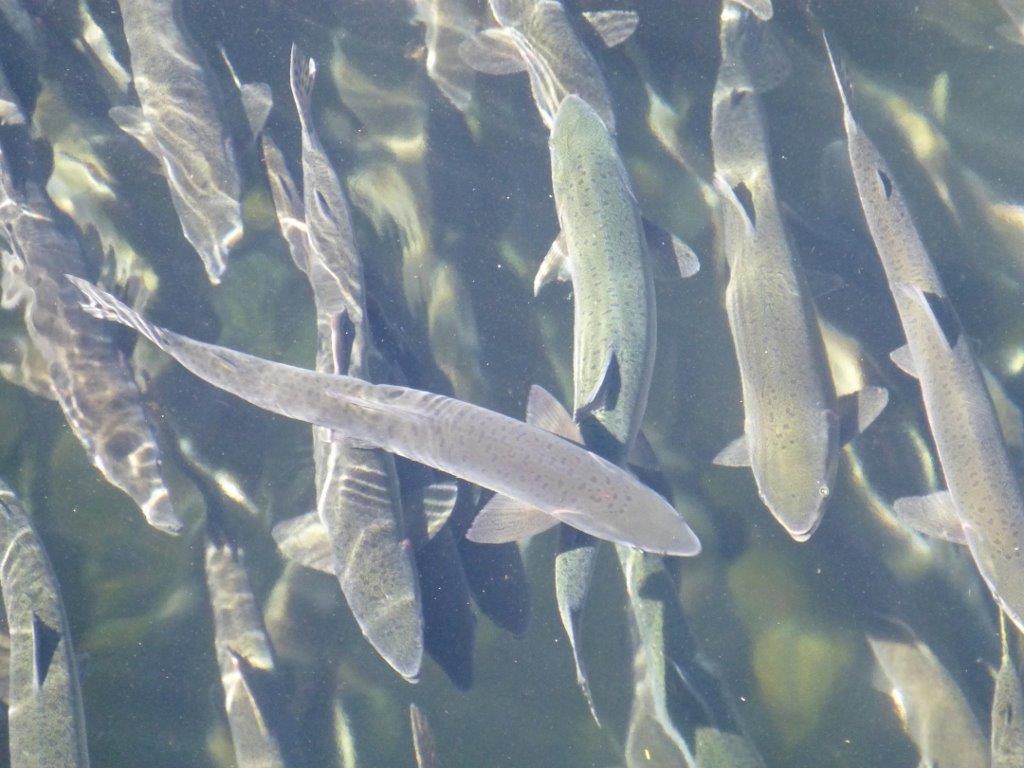
Pink salmon gather at the mouth of Starrigavan Creek in Sitka. in some markets, the roe of this species can be more valuable than the flesh. (KCAW photo/Rich McClear)
Russia’s ongoing embargo of American agricultural and seafood products has produced some sharp rhetoric from political leaders — including Alaska’s senators. But the true impact of embargo on the Alaska seafood industry remains unclear. Because of robust markets elsewhere for some of the products favored by Russians — like salmon caviar — the showdown may be more about politics than economics.
International diplomacy is often likened to a chess game. A movement on one part of the chess board affects play on the whole board. Russia annexed the Crimea on the Black Sea in Southern Europe this spring, the US imposed selected economic sanctions on Russia and Russia turned around and embargoed American food products, including Alaska seafood.
The Cold war has been over for 25 years, but you wouldn’t guess that from recent remarks by Alaska’s two senators. Here is Mark Begich speaking to the Sitka Chamber of Commerce.
“Russia does not take our fish product anymore. Now let me make it very clear, if they don’t reverse this and Russia does not open their markets back up I will do everything I can to close their markets here in the US.”
Mathew Felling, communications director for Senator Lisa Murkowski also takes a hard line.
“It there’s anything we’ve learned about Putin in the last year it’s that he sees the value of forceful meaningful action and if Putin wants to use fish or food as a weapon we need to demonstrate that we are prepared to respond in-kind.”
A consortium of seafood producers has asked the Alaska Congressional Delegation propose a ban on the import of Russian seafood to America in retaliation for Russia’s embargo on Alaska seafood. Terry Shaff signed the request on behalf of 9 processors. Schaff is president of UniSea Seafoods, a processor in Unalaska shipping Surimi to Russia. UniSea had a shipment of Surimi enroute to Russia when the embargo went into effect. They had to divert six containers to a warehouse in Germany.
“There’s definitely a cost for us taking it to Germany, having to find new customers. And then we’ll have to go back through and re-label every single carton in those containers because they were destined for the Russian market and had Russian markings on them.”
Surimi is made from pollock and is found in fish sticks and imitation crab. But Shaff says the greatest harm to the Alaska seafood industry could be to salmon producers. Alexa Takovic, with the Alaska Seafood Marketing Institute agrees.
“Because of the roe and because of the sheer volume of salmon that had previously been exported to Russia.”
Caviar is made from the roe of chum and pink salmon and Russia is Alaska’s second largest market for salmon roe. I called several Southeast Alaska salmon processors. None would talk to me on the record. However one processor, off the record, said he didn’t really see a problem because the pink and chum catches were down this year and there may not be enough Alaska product to meet the worldwide demand. The Alaska Department of Fish and Game estimates that this year’s combined pink and chum catch was more than one hundred million fish below the 2013 take.
ASMIs Tankovic partly agrees but still sees a problem.
“Better to have it happen this year when we have lower harvests than last year when we had record harvests. That said I don’t think it’s entirely accurate to say that there would be no or minimal impact since Russia is still our second largest salmon roe market. And the second thing you have to consider too is that Russia imported quite a bit of salmon from Norway in particular and European exports to Russia are also sanctioned. That product going into other markets will have an impact on Alaska Salmon.”
In other words, Norwegian salmon that would have gone to Russia will now be competing with Alaska salmon in markets in the rest of the world. Steve Reifenstuhl, general manager of the Northern Southeast Regional Aquaculture Association gave another reason for concern.
Reifenstuhl — Last year fisheries across the state were very very good and we broke the all-time record by a large margin and because of that there is somewhat of a glut on the market. All that fish that was harvested and processed last year hasn’t been moved.
So this year’s catch is competing with last year’s catch in the international market, so the loss of the Russian market could be a problem. Nevertheless, Tankovic said that ASMI started developing alternative markets as soon as they saw the possibility of conflict between the US and Russia.
Tankovic — We, as an international marketing program, have anticipated that we may want to look to other markets for roe. China, Germany, and France are the next biggest roe markets after Japan and after Russia. We have also considered other Eastern European Markets.
Reifenstuhl — Anyplace there is an emerging middle class.
NSRAA’s Reifenstuhl sees the market for Alaska caviar expanding to new markets beyond Eastern Europe.
Reifenstuhl — South America, Africa, Asia, China, they look to what the rich people are eating and sure enough, they want Salmon and that’s been great for Alaska.
Tankovic — In the short term it creates a little bit of confusion. That said, I think we’re really a resilient industry. There will be a minor impact but I think we will get past it.
So, when exactly the Russian embargo ends remains a question for senators and diplomats. The question for Alaska seafood producers is slightly different: When Russian markets re-open, will Alaska need them?































